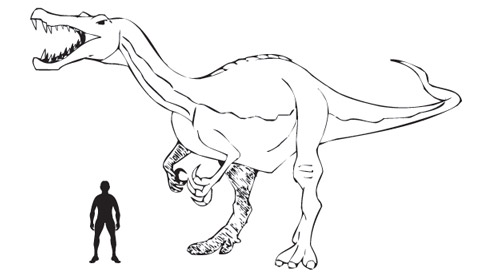Young boy finds Dinosaur Tooth on First Fossil hunting Expedition
Trip to the Isle of Wight – Dinosaur Tooth Found
For young Josef Bangbala, his first fossil hunting trip turned out to be a red letter day for Isle of Wight palaeontologists. Josef, aged seven, was out on an organised fossil hunting trip with his father whilst on holiday on the Isle of Wight. Keen eyed Josef spotted a two-inch long dinosaur tooth, one of the largest found on the island.
His find has sparked a debate amongst scientists as the tooth, believed to belong to a baryonychid may lead to a re-think over the size and scale of these predatory dinosaurs.
Josef was on a special fossil hunting expedition during half term with his dad Tom, 52, of Stacksteads, Rossendale.
Tom said: “He is into dinosaurs and wants to be a palaeontologist when he is older and so I took him to the Isle of White on the trip last week”.
The southern part of the Isle of Wight has a number of Cretaceous sediments exposed, in fact unusually, the only surface rocks on the island are sedimentary and they only herald from three geological periods. A number of dinosaur fossils have been found on the island, particularly in the south-west between Compton Chine and Atherfield Point. Wave action is constantly exposing new strata at the shoreline, providing opportunities for new fossils to come to light.
Josef’s dad went on to explain: “we were on the beach and he saw it sticking out of the shale. We showed it to the specialist we were with and he was beside himself. He said it was the best thing they have found for at least three years. They wanted to borrow it for a year and put it in the museum on display with Josef’s picture.”
A number of baryonychid teeth have been found but the size of this one makes it particularly special and may indicate that animals such as Baryonyx may have exceeded 10 metres in length.
An Illustration of Baryonyx (Baryonychid)

Picture credit: Everything Dinosaur
Baryonyx was a large meat-eating dinosaur of the Early Cretaceous, a possible ancestor of the spinosaurs. The name means “heavy claw” after the long, re-curved, sharp claws on its thumbs. It is believed this animal was a fish-eater, although it probably was an opportunist hunter, feeding on other dinosaurs as well as scavenging the kills of other carnivores. The first fossils of Baryonyx were discovered by an amateur fossil hunter called William Walker on a visit to a clay pit in Surrey, southern England. About 70% of the entire skeleton of this first specimen was found and although not fully grown, careful study of this fossil has led scientists to speculate that creatures such as Baryonyx could grow to lengths in excess of 10 metres. The large tooth found by Josef also indicates that Baryonyx could have been larger than first thought.
Steve Hutt, curator of Dinosaur Isle, on the Isle of Wight, described the tooth as “extra special” as it was much larger than other teeth found on the island.
“We find things everyday but once every few years we find something extra special like this fossil. I would have been proud to have found it myself. It is particularly extra lucky to have found it on his first hunt. He is so young and he found it all by himself.”
Children often find fossils, there are a number of reasons for this, their eyesight is much more acute than an adult’s and they are able to discern strange objects amongst stones and debris. Also being closer to the ground than an adult, they are often able to spot things overlooked by even the most dedicated expert. Scientists are confident that this tooth is from a baryonychid as teeth from these dinosaurs are very characteristic. They tend to be less re-curved than other large Theropod teeth, but the give-away is their unusually fine serrations (7 per mm). These serrations are called denticles and are used to help determine the type of meat-eating dinosaur the tooth came from. The tooth does not have a root, so it is likely that it was shed when the animal was alive. Teeth with roots are usually associated with a dead animal, the teeth falling out of the skull complete, as the flesh rots away.
To see a model of Baryonyx: CollectA Prehistoric Life Models.

